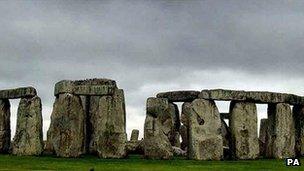Stonehenge builders travelled from far, say researchers
- Published

Thousands of people came from across Britain to help build Stonehenge, experts investigating the origins of the monument have said.
They said people travelled from as far afield as the Scottish Highlands.
Researchers from University College London said their findings overturned what was thought about the origins of the monument.
Until now it had been thought that Stonehenge was built as an astronomical calendar or observatory.
The latest findings, which came after a decade of research, suggested it was the act of building the monument rather than its purpose that was key.
The researchers believed as many as 4,000 people gathered at the site, at a time when Britain's population was only tens of thousands.
'Not all fun'
Analysis of animal teeth found at a nearby settlement suggested people travelled the length of the country to help with the building.
Professor Mike Parker Pearson, from University College London, said the scene would have resembled a cross between the Glastonbury Festival and a motorway building scheme.
He said a settlement at nearby Durrington Walls had about 1,000 homes, the "largest Neolithic settlement in the whole of northern Europe".
Prof Parker Pearson said: "What we have discovered is it's in building the thing that's important. It's not that they're coming to worship, they're coming to construct it."
He added: "It's something that's Glastonbury Festival and a motorway building scheme at the same time. It's not all fun, there's work too."
The academics suggested that Stonehenge was built about 200 years earlier than previously thought, some 4,500 years ago.
Their findings will be revealed in a Channel 4 documentary, Secrets of the Stonehenge Skeletons.
- Published19 February 2013
- Published21 December 2012
- Published2 October 2012